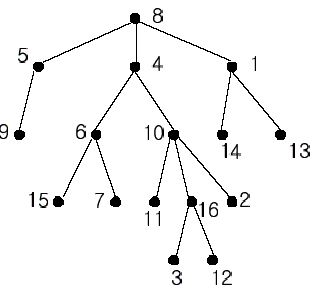How far away ?
Time Limit: 2000/1000 MS (Java/Others) Memory Limit: 32768/32768 K (Java/Others)
Total Submission(s): 9097 Accepted Submission(s): 3171
For each test case,in the first line there are two numbers n(2<=n<=40000) and m (1<=m<=200),the number of houses and the number of queries. The following n-1 lines each consisting three numbers i,j,k, separated bu a single space, meaning that there is a road connecting house i and house j,with length k(0<k<=40000).The houses are labeled from 1 to n.
Next m lines each has distinct integers i and j, you areato answer the distance between house i and house j.
描述:
已知在一个村庄中有n个房子,一些双向的道路把这些房子连接了起来。但是每天都有人询问诸如“如果我想从A房子走到B房子需要走多远的距离?” 的问题。幸运的是,在这个村庄中这个答案总是唯一的,因为任意两个房子之间仅存在一条简单路径(路径上的地点只能访问一次)。你现在的任务是回答这些人的询问。
输入:
输入一个整数n表示房子总数,一个整数m表示询问的总数(n<=40000,m<=200),接下来的n-1行输入n-1条道路的状况,每行3个整数a,b,c表示a房子和b房子之间有一条长度为c的双向道路,接下来输入m行询问,每行两个整数a,b要求给出a房子和b房子的最小距离。
思路: 可以用LCA算法计算出任意两个房子u,v的最近公共祖先lca(u,v)
假设d[]数组为每个房子节点到根节点的距离,那么有
dis(u, v) = d[u] + d[v] – 2*d[lca(u, v)]
在线算法
/* 这个版本的在线算法比自创的好看简洁多了,可以当模板,效率不高在于算法其本身的原因; 据说离线算法要快不少。 */ #include <cstdio> #include <cstring> #include <iostream> #include <cmath> #include <vector> using namespace std; const int NN=50000; int n,rt; vector<pair<int,int> > edge[NN]; int depth=0; int bn=0,b[NN*2]; //深度序列 int f[NN*2]; //对应深度序列中的结点编号 int p[NN]; //结点在深度序列中的首位置 int dis[NN]; //结点到根的距离 void dfs(int u,int fa) { int tmp=++depth; b[++bn]=tmp; f[tmp]=u; p[u]=bn; for (int i=0; i<edge[u].size(); i++) { int v=edge[u][i].first; if (v==fa) continue; dis[v]=dis[u]+edge[u][i].second; dfs(v,u); b[++bn]=tmp; } } int dp[NN*2][20]; void rmq_init(int n) //以深度序列做rmq { for (int i=1; i<=n; i++) dp[i][0]=b[i]; int m=floor(log(n*1.0)/log(2.0)); for (int j=1; j<=m; j++) for (int i=1; i<=n-(1<<j)+1; i++) dp[i][j]=min(dp[i][j-1],dp[i+(1<<(j-1))][j-1]); } int rmq(int l,int r) { int k=floor(log((r-l+1)*1.0)/log(2.0)); return min(dp[l][k],dp[r-(1<<k)+1][k]); } int lca(int a,int b) { if (p[a]>p[b]) swap(a,b); int k=rmq(p[a],p[b]); return f[k]; } int main() { int m,u,v,w; int t; scanf("%d",&t); while(t--){ scanf("%d%d",&n,&m); for (int i=1; i<=n; i++) edge[i].clear(); for(int i=1;i<n;i++) { scanf("%d%d%d",&u,&v,&w); edge[u].push_back(make_pair(v,w)); edge[v].push_back(make_pair(u,w)); } rt=1; dis[rt]=0; dfs(1,0); rmq_init(bn); while (m--) { scanf("%d%d",&u,&v); printf("%d\n",dis[u]+dis[v]-2*dis[lca(u,v)]); } } return 0; }
离线算法
#include <cstdio>
#include <cstring>
#include <iostream>
#include <vector>
using namespace std;
const int NN=50010;
int n,m;
vector<pair<int,int> > edge[NN],qe[NN];
vector<int> q1,q2;
int p[NN];
int find(int x)
{
if (p[x]!=x) p[x]=find(p[x]);
return p[x];
}
int sum=0,ans[NN],dis[NN];
bool vis[NN]={0};
void lca(int u,int fa)
{
p[u]=u;
for (int i=0; i<edge[u].size(); i++)
{
int v=edge[u][i].first;
if (v==fa) continue;
dis[v]=dis[u]+edge[u][i].second;
lca(v,u);
p[v]=u;
}
vis[u]=true;
if (sum==m) return;
for (int i=0; i<qe[u].size(); i++)
{
int v=qe[u][i].first;
if (vis[v])
ans[qe[u][i].second]=dis[u]+dis[v]-2*dis[find(v)];
}
}
int main()
{
int u,v,w;
int t;
scanf("%d",&t);
while(t--){
scanf("%d%d",&n,&m);
for (int i=1; i<=n; i++)
{
edge[i].clear();
}
for (int i=1; i<n; i++)
{
scanf("%d%d%d",&u,&v,&w);
edge[u].push_back(make_pair(v,w));
edge[v].push_back(make_pair(u,w));
}
for (int i=0; i<m; i++)
{
scanf("%d%d",&u,&v);
qe[u].push_back(make_pair(v,i));
qe[v].push_back(make_pair(u,i));
ans[i]=0;
}
dis[1]=0;
lca(1,0);
for (int i=0; i<m; i++) printf("%d\n",ans[i]);
}
return 0;
}
| Time Limit: 1000MS | Memory Limit: 10000K | |
| Total Submissions: 22116 | Accepted: 11566 |
Description

In the figure, each node is labeled with an integer from {1, 2,...,16}. Node 8 is the root of the tree. Node x is an ancestor of node y if node x is in the path between the root and node y. For example, node 4 is an ancestor of node 16. Node 10 is also an ancestor of node 16. As a matter of fact, nodes 8, 4, 10, and 16 are the ancestors of node 16. Remember that a node is an ancestor of itself. Nodes 8, 4, 6, and 7 are the ancestors of node 7. A node x is called a common ancestor of two different nodes y and z if node x is an ancestor of node y and an ancestor of node z. Thus, nodes 8 and 4 are the common ancestors of nodes 16 and 7. A node x is called the nearest common ancestor of nodes y and z if x is a common ancestor of y and z and nearest to y and z among their common ancestors. Hence, the nearest common ancestor of nodes 16 and 7 is node 4. Node 4 is nearer to nodes 16 and 7 than node 8 is.
For other examples, the nearest common ancestor of nodes 2 and 3 is node 10, the nearest common ancestor of nodes 6 and 13 is node 8, and the nearest common ancestor of nodes 4 and 12 is node 4. In the last example, if y is an ancestor of z, then the nearest common ancestor of y and z is y.
Write a program that finds the nearest common ancestor of two distinct nodes in a tree.
Input
Output
Sample Input
2 16 1 14 8 5 10 16 5 9 4 6 8 4 4 10 1 13 6 15 10 11 6 7 10 2 16 3 8 1 16 12 16 7 5 2 3 3 4 3 1 1 5 3 5
Sample Output
4 3
Source
//这个tarjan算法使用了并查集+dfs的操作。中间的那个并查集操作的作用,只是将已经查找过的节点捆成一个集合然后再指向一个公共的祖先。另外,如果要查询LCA(a,b),必须把(a,b)和(b,a)都加入邻接表。 // //O(n+Q) #include <iostream> #include <cstdio> #include <cstring> #include <vector> using namespace std; #define MAXN 10001 int n,fa[MAXN]; int rank[MAXN]; int indegree[MAXN]; int vis[MAXN]; vector<int> hash[MAXN],Qes[MAXN]; int ances[MAXN];//祖先 void init(int n) { for(int i=0;i<=n;i++) { fa[i]=i; rank[i]=0; indegree[i]=0; vis[i]=0; ances[i]=0; hash[i].clear(); Qes[i].clear(); } } int find(int x) { if(x != fa[x]) fa[x]=find(fa[x]); return fa[x]; } void unio(int x,int y) { int fx=find(x),fy=find(y); if(fx==fy) return ; if(rank[fy]<rank[fx]) fa[fy]=fx; else { fa[fx]=fy; if(rank[fx]==rank[fy]) rank[fy]++; } } void Tarjan(int u) { ances[u]=u; int i,size = hash[u].size(); for(i=0;i<size;i++) { Tarjan(hash[u][i]);//递归处理儿子 unio(u,hash[u][i]);//将儿子父亲合并,合并时会将儿子的父亲改为u ances[find(u)]=u;//此时find(u)仍为u,即 } vis[u]=1; //查询 size = Qes[u].size(); for(i=0;i<size;i++) { if(vis[Qes[u][i]]==1)//即查询的另一个结点开始已经访问过,当前的u在此回合访问。 { printf("%d\n",ances[find(Qes[u][i])]);//由于递归,此时还是在u return; } } } int main() { int t; int i,j; scanf("%d",&t); while(t--) { scanf("%d",&n); init(n); int s,d; for(i=1;i<=n-1;i++) { scanf("%d%d",&s,&d); hash[s].push_back(d); indegree[d]++; } scanf("%d%d",&s,&d); // if(s==d)//如果需要计数的时候注意 // ans[d]++; // else // { Qes[s].push_back(d); Qes[d].push_back(s); // } for(j=1;j<=n;j++) { if(indegree[j]==0) { Tarjan(j); break; } } } return 0; }























 1万+
1万+

 被折叠的 条评论
为什么被折叠?
被折叠的 条评论
为什么被折叠?








